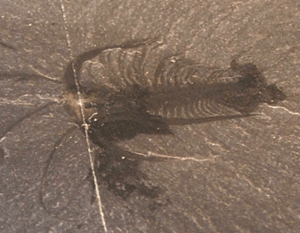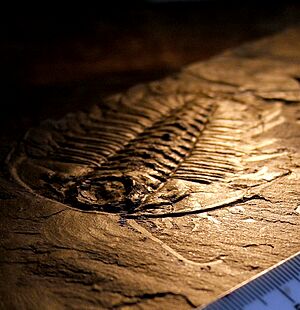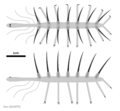Cambrian facts for kids


Imagine a time when Earth looked very different! The Cambrian Period was the first part of the Paleozoic Era. It started about 541 million years ago and ended around 485.4 million years ago. Before it, there was the Ediacaran Period, and after it came the Ordovician Period.
During the Cambrian, life on Earth changed a lot. Before this period, most living things were tiny and simple. But in the Cambrian, many new and complex animals appeared. This quick increase in different life forms is called the Cambrian explosion. It's when the main groups of animals we know today, called phyla, first showed up!
Scientists have learned a lot about Cambrian animals, even their soft parts. This is thanks to special places called lagerstätten. These are fossil sites where even soft body parts, which usually decay, were preserved. This helps us understand Cambrian life better than some later periods.
Almost all the new life during the Cambrian lived in the oceans. The land was mostly covered by a thin layer of microbes. The Earth had warm, shallow seas because a huge supercontinent called Pannotia had broken apart. There was no ice at the North or South Pole. Many animals also started to grow hard shells during this time.
How the Seafloor Changed
At the start of the Cambrian, some older animals, like the Ediacaran biota, might have disappeared. It seems that new types of animals began to burrow into the seafloor. This changed the environment for the older life forms. The burrowing probably stirred up the mats of bacteria and algae that covered the ocean floor. Around this time, we find the first signs of many different animal groups. We even find some fossil traces on what was land, suggesting a few Cambrian creatures might have left the water.
Amazing Cambrian Fossils
Fossils from the Cambrian Period are special because they sometimes show the soft parts of animals. Most fossils only preserve hard parts like bones or shells. A famous place for these amazing fossils is the Burgess Shale in Ontario, Canada.
Here are some of the first times certain animal groups appeared, starting with the oldest:
- The first Cnidaria (like jellyfish) and probable annelids (like worms) appeared about 580 million years ago, in the Ediacaran Period.
- Small shelly fossils (SSF), including the first molluscs and brachiopods, showed up about 537 million years ago.
- The first trilobites, which were very common, appeared about 526 million years ago.
- The first echinoderms (like starfish) came about 522 million years ago.
- The first crustaceans (like crabs) appeared about 510 million years ago.
Sometimes, it's hard for scientists to figure out exactly which group a fossil belongs to. So, some fossils are still being studied and discussed, even many years after they were found!
Images for kids
-
Archeocyathids from the Poleta formation in the Death Valley area
-
A reconstruction of Margaretia dorus from the Burgess Shale. They were once thought to be green algae, but are now known to be related to hemichordates.
-
Stromatolites of the Pika Formation (Middle Cambrian) near Helen Lake, Banff National Park, Canada
-
Trilobites were very common during this time.
-
Anomalocaris was an early ocean predator, one of the many arthropods of the time.
-
Opabinia was a creature with an unusual body plan; it was probably related to arthropods.
-
Hallucigenia sparsa was a member of the lobopodian group, related to modern velvet worms.
-
Cambroraster falcatus was a large arthropod for that era.
See also
 In Spanish: Cámbrico para niños
In Spanish: Cámbrico para niños












